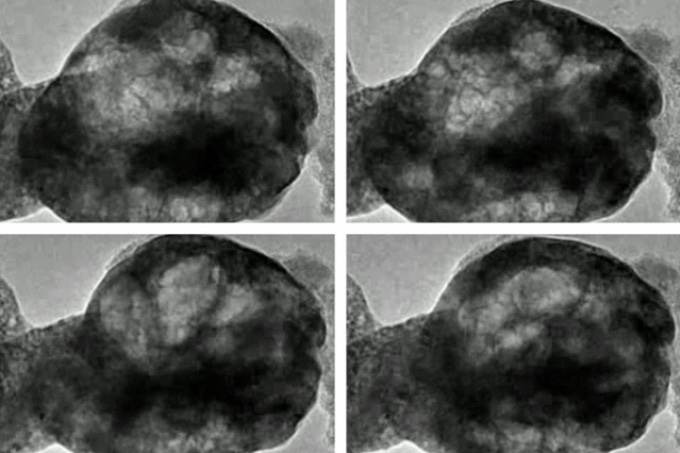Oct 5 2016
 These images, taken from a transmission electron microscope, show a perovskite material oscillating as it is exposed to water vapor and a beam of electrons. (Credit: Courtesy of the Researchers)
These images, taken from a transmission electron microscope, show a perovskite material oscillating as it is exposed to water vapor and a beam of electrons. (Credit: Courtesy of the Researchers)
Perovskite is a type of oxide structure, and researchers have discovered it has an unexpected and unique behavior when exposed to streams of electrons and water vapor. The material emits oxygen and began to oscillate, closely resembling a living, breathing organism.
Yang Shao-Horn, the W.M. Keck Professor of Energy at MIT stated that the occurrence was "totally unexpected" and is likely to have some practical applications. Shao-Horn is the senior author of a paper explaining the research that is published in the Nature Materials journal. The lead author of the paper is Binghong Han PhD '16, now a postdoc at Argonne National Laboratory.
Perovskite oxides are promising materials for a number of applications, including solar cells, fuel cells, water-splitting devices to generate hydrogen and oxygen, electrodes in rechargeable batteries, and sensors. In several of these applications, the materials would be exposed to water vapor, therefore a detailed understanding of their behavior in such an environment is vital to enable the development of several of their potential applications.
Like Cooking Polenta
When a perovskite known as BSCF (based on the chemical symbols for its constituents barium, strontium, cobalt, and iron) is placed in a vacuum in a transmission electron microscope (TEM) to monitor its behavior, "nothing happens, it's very stable." But then, "when you pump in low pressure water vapor, you begin to see the oxide oscillate" Shao-Horn says. The cause of that oscillation, clearly visible in the TEM images, is that "bubbles form and shrink in the oxide. It's like cooking a polenta, where bubbles form and then shrink."
The behavior was unanticipated partly because the oxide is solid and was thought not to have the flexibility to form increasing and shrinking bubbles.
"This is incredible, we think of oxides as brittle, but in this case the bubbles expand and contract without any fracturing of the material. And in the process of bubble formation, we are actually generating oxygen gas.
Yang Shao-Horn, MIT
Furthermore, the exact frequency of the oscillations that are produced by the forming and bursting bubbles can be accurately tuned, which could be a useful attribute for certain potential applications.
"The magnitude and frequency of the oscillations depend on the pressure" of the vapor in the system, Shao-Horn says.
As the occurrence also depends on the existence of electron beams, the reaction can be switched on and off as and when required by manipulating those beams.
It is not only a surface reaction, she says. The water molecules, which become ionized by the electron beam, actually enter deep into the perovskite.
"These ions go inside the bulk material, so we see oscillations coming from very deep," she says.
This experiment used the exceptional capabilities of an "environmental" transmission electron microscope at Brookhaven National Laboratory, part of a U.S. Department of Energy-supported facility there. With this tool, the team directly observed the interaction between the perovskite material, streams of electrons, and water vapor, at atomic scale.
Keeping its Shape
Despite all of the pulsating motion and the infiltration of ions in and out of the solid crystalline material, when the reaction halts, the material "still has its original perovskite structure," Han says.
Since this is such a new and fascinating discovery, Shao-Horn says, "we still don't understand in full detail" precisely how the reactions occur, so the research is continuing in order to simplify the mechanisms. "It's an unexpected result that opens a lot of questions to address scientifically."
The preliminary experiments used electron beams. Shao-Horn wonders if such behavior could also be stimulated by shining a bright light, which could be a practical method for water splitting and purification - for instance, using sunlight to eliminate toxins from water or produce hydrogen fuel from water.
While most catalysts aid reactions only at their surfaces, the fact that this reaction enters into the bulk of the material indicates that it could present a new system for catalyst designs, she says.
Besides mechanical engineering, Shao-Horn holds joint appointments with the Department of Materials Science and Engineering and the MIT Energy Initiative's Center for Energy Storage. The research team also included Kelsey Stoerzinger PhD '16; Vasili Tileli of the Ecole Polytechnique Federale de Lausanne, in Switzerland; and Andrew Gamalski and Eric Stach of Brookhaven National Laboratory, in Upton, New York. The work was supported by the National Science Foundation, the Skoltech-MIT Center for Electrochemical Energy Storage, and the U.S. Department of Energy Office of Science.